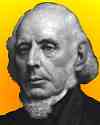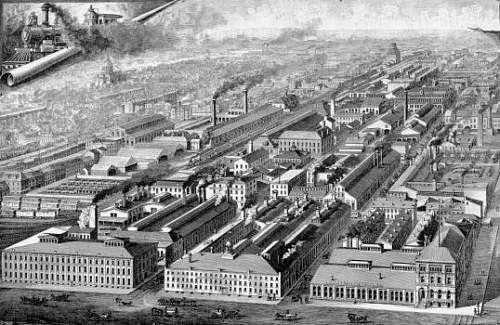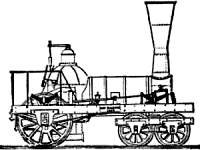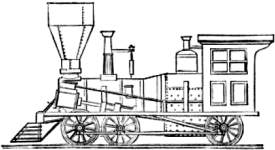 (source)
(source)
|
Matthias Baldwin
(10 Dec 1795 - 7 Sep 1866)
American manufacturer who developed steam-tight metal joints that enabled steam locomotives to operate at double the earlier steam pressure, giving better performance. His works produced over 1,000 locomotives.
|
The Baldwin Locomotive Works
From History of Philadelphia, 1609-1884 (1884)

Established 1831. Annual Capacity, 600. (source)
The Baldwin Locomotive Works stand pre-eminent among all the companies engaged in the manufacture of railway machinery. Its origin is contemporaneous with the inception of railways in America; its growth has been a progress in every respect commensurate with the development of railroad construction; its history reflects the great advance made in transportation by steam. These great works owe their existence to and take their name from their founder, Matthias W. Baldwin, who was born in Elizabethtown, N. J., Dec. 10, 1795, and in 1817 entered the service of Fletcher & Gardner, jewelers and silversmiths, in this city. After a short time spent in this business on his own account, he formed, in 1825, a copartnership with David Mason, a machinist, for the manufacture of book-binders' tools and cylinders for calico-printing. Their first shop was in a small alley running north from Walnut Street, above Fourth; but it was in a shop on Minor Street, to which his business was removed, that Mr. Baldwin illustrated inventive genius by constructing an engine adapted to the motive-power of a small factory, where economy of space was an object. It was an upright engine, combining power with such excellency of workmanship and efficiency that it not only performed all the duties expected of it, but has since successfully supplied the motive-power to six different departments of the works as they have been opened, and is to-day preserved in good order. From this success the manufacture of stationary steam-engines took a prominent place in the establishment. Mr. Mason withdrew from the firm soon after, and Mr. Baldwin continued the construction of engines. It was in 1829-30 that steam, as a motive-power on railroads, began to attract the attention of American engineers. A few English locomotives had been introduced, and for the gratification of public curiosity Mr. Baldwin constructed for Peale's Museum a miniature locomotive, not copied from the English, but constructed from published descriptions and sketches of engines which had taken part in the Rainhill competition in England. The little machine was completed on April 25, 1831, and put in motion on a circular track made of pine boards, covered with hoop-iron, in the rooms of Peale's Museum. It drew two small cars, holding four persons, and attracted great attention from the crowds that saw it. Both anthracite and pine-knot coal were used as fuel, and the steam was discharged through the smoke-stack to increase the draught.
The success of the model obtained for Mr. Baldwin an order for a locomotive for the Philadelphia, Germantown and Norristown Railroad Company. An examination of an engine imported from England for the Camden and Amboy Railroad Company, but which had not been put together, enabled him to improve upon the model of his miniature engine. There were few mechanics capable of doing the necessary work, and even suitable tools had to be first made. Nevertheless, obstacles were removed, and the difficulties overcome by the genius and perseverance of the builder, and the work was prosecuted to completion. "Old Ironsides" left the shop on Minor Street for that on Lodge Alley, where it was completed, and on Nov. 23, 1832, stood upon the rails like a "thing of life." Its light weight—between four and five tons—did not give it that tractive power necessary to draw a loaded train on wet and slippery rails, hence in the newspapers of the day it was termed a "fair weather" locomotive, because the notices specified that "the locomotive engine built by Mr. M. W. Baldwin, of this city, will depart daily, when the weather is fair, with a train of passenger cars. On rainy days horses will be attached."
The "Old Ironsides" was a four-wheeled engine, modeled essentially on the English fashion of that day, as shown in the "Planet" class, and weighed, in running order, something near five tons. The rear or driving-wheels were 54 inches in diameter, on a crank axle placed in the fire-box. The cranks were 39 inches from centre to centre. The front wheels, which were simply carrying wheels, were 45 inches in diameter, on an axle placed just back of the cylinders. The cylinders were 9½ inches in diameter by 18 inches stroke, and were attached horizontally to the outside of the smoke-box, which was D-shaped, with sides receding inwardly, so as to bring the centre line of each cylinder in line with the centre of the crank. The wheels were made with heavy cast-iron hubs, wooden spokes and rims, and wrought-iron tires. The frame was of wood, placed outside the wheels. The boiler was thirty inches in diameter, and contained seventy-two copper flues, 1½ inches in diameter, and 7 feet long. The tender was a four-wheeled platform, with wooden sides and back, carrying an iron box for a water-tank, inclosed in a wooden casing, and with a space for fuel in front. The engine had no cab. The valve motion was at first given by a single loose eccentric for each cylinder, placed on the axle between the crank and hub of the wheel. On the inside of the eccentric was a half-circular slot, running half way round. A strap was fastened to the axle at the arm of the crank, terminating in a pin which projected into the slot. The engine was reversed by changing the position of the eccentric on the axle by a lever operated from the footboard.
The price of the engine was to have been $4000, but the company claimed that it did not perform according to contract, and after correction had been made as far as possible, a compromise was effected, and Mr. Baldwin received $3500 for his work.

The "Old Ironsides,"on subsequent trials, attained a speed of thirty miles an hour with the usual train. Such was the first locomotive made by Mr. Baldwin, and such was his own disappointment that be said, with much decision, "That is our last locomotive." The "Miller," for the Charleston and Hamburg (S. C.) Railroad Company, was the next engine built by Mr. Baldwin. A visit to, and thorough inspection of, an English locomotive, built by Robert Stevenson & Co., of Newcastle, England, for the Mohawk and Hudson Railroad, enabled Mr. Baldwin to introduce improvements which obviated some of the defects which had made the "Old Ironsides" less successful than he anticipated it would be. During 1834 Mr. Baldwin completed five locomotives, and the business was now fairly under way.
The business of locomotive building, in 1834, compelled another change of quarters, and from Lodge Alley Mr. Baldwin removed his shops to the location on Broad and Hamilton Streets, where, in 1835, the present Baldwin Locomotive Works had their origin, and where they have since developed into their immense proportions.
These financial troubles had their effect in diminishing the orders for locomotives, and the establishment of other locomotive works also tended to decrease the business. In April, 1839, Messrs. Vail and Hufty became associated with Mr. Baldwin, the style of the firm being Baldwin, Vail & Hufty, which so remained until 1841, when Mr. Hufty withdrew, and the style was changed to Baldwin & Vail, which firm continued until 1842.
The problem of utilizing the weight of the engine for adhesion was not solved until his inventive mind had produced his six-wheel-connected locomotive, with four front drivers combined. The patent for this machine was secured Aug. 25, 1842, and has contributed more to the success of the Baldwin Locomotive Works, as well as to the fortune of Mr. Baldwin, than any other of his inventions.

This machine seemed to revive business. In 1843 12 engines were constructed; in 1844, 22; in 1845, 27. The partnership with Mr. Vail was dissolved in 1842, and Asa Whitney became a partner under the style of Baldwin & Whitney, which continued until 1846, when the latter withdrew to form the house of A. Whitney & Sons, for the manufacture of car-wheels.
As early as 1840 the reputation of Mr. Baldwin attracted attention in Europe, and he received through August Belmont, of New York, an order for a locomotive for Austria, and in 1845 he constructed three locomotives for the Royal Railroad Committee of Wurtemberg. In 1854, Matthew Baird, who had been connected with the works since 1836, was admitted to partnership, under the title of M. W. Baldwin & Co.
The year 1861, when the civil war was breaking out, witnessed a falling off in the production of locomotives, only forty being built during that year, and it was seriously contemplated to turn the resources of the establishment to the manufacture of shot and shell and other munitions of war. It was soon seen, however, that war had its advantages as well as disadvantages, and that the demand for transportation of armies, supplies, and munitions would more than compensate for all the diminution of ordinary freight caused by the disturbance of trade and commerce. The movement of armies and their impedimenta taxed the capacity of every railroad, and compelled the enlargement of all of their facilities. This, in turn, demanded of every Northern workshop the fullest exertion to supply the pressing demand, and the government became a purchaser of locomotives. In 1862 the works turned out 72 locomotives; in 1883, 96; in 1864,130; in 1865, 115.
Mr. Baldwin died Sept. 7, 1865, after he had practically perfected the locomotive, and witnessed the rise and wonderful increase of the most important material interest of the age, to the completion of which he had contributed more than any other individual. His name was familiar wherever the locomotive was known, and his personal character as a Christian and a philanthropist was as highly esteemed by his associates and acquaintances as his scientific achievements were valued by his profession.
In 1867 the establishment was reorganized as "The Baldwin Locomotive Works," M. Baird & Co., proprietors, Messrs. George Burnham and Charles T. Parry, who had been connected with the establishment from an early period, being associated with Mr. Baird. In 1870, Edward H. Williams, William P. Henzey, and Edward Longstreth became members of the firm. The production of the works was: for 1866, 118 locomotives; for 1867, 127; for 1868, 124; for 1869, 235; for 1870, 280; for 1871, 331.
In 1873, Mr. Baird retired, and the style of the firm became Burnham, Parry, Williams & Co., and John H. Converse, who had been connected with the works since 1870, was admitted as a member of the firm. The product for 1873 was 437 locomotives, and nearly 3000 men were employed. Owing to the financial troubles of the fall of 1873 only 205 locomotives were turned out in 1874, and 135 in 1875. The number increased in 1876 to 232; in 1877 the number was 185; in 1878 it had increased to 298; in 1879 the number was 398, and in 1880 the number turned out was 515. In 1882 the works employed 3000 men and made an average of 12 locomotives weekly; 565 for the year 1882, and at the rate of 600 for 1883. These range in size from the steam motors and smaller engines for narrow-gauge roads to the heaviest freight engines known. Of the number made in 1882, one hundred were exported to Mexico, Brazil, and Australia. Nearly all the locomotives exported from the port of New York during the past ten years were from these works. All the processes of manufacture from the crude materials are conducted at these works, including the heaviest foundry work and forgings. Eleven steam hammers, ranging from 600 to 6000 pounds each, are in use, forging all the shapes and axles required by the works. The wheels are also made here, and the steel tires are the only parts not made at these works as recently enlarged.
In an existence of nearly half a century this factory has constructed over 5000 locomotives. The present capacity is equal to nearly two locomotives for each day of the year. Nine acres of ground are occupied by the works; the number of hands employed ranges from 2600 to 3000; the plant comprises 734 machine tools; and drawings and patterns for over 500 different sizes or styles of locomotives, for all existing guages and every description of service, are included in the working lists of this, the largest locomotive manufactory in the world.
- 10 Dec - short biography, births, deaths and events on date of Baldwin's birth.
- Matthias Baldwin - Biography from National Cyclopaedia of American Biography (1899)
- M. W. Baldwin & Co.'s Locomotive Works - from A History of American Manufactures from 1608 to 1860 (1864).
- Perfecting the American Steam Locomotive, by J. Parker Lamb. - book suggestion.
- The Baldwin Locomotive Works, 1831-1915: A Study in American Industrial Practice, by John K. Brown. - book suggestion.
- Booklist for Steam Locomotives.




